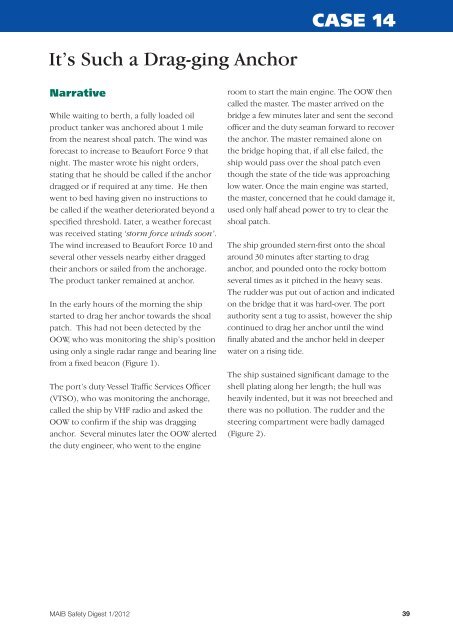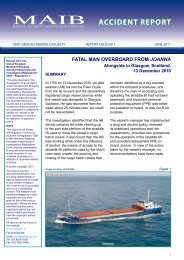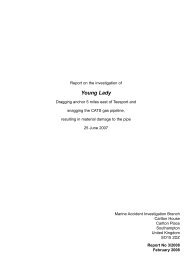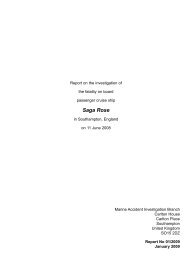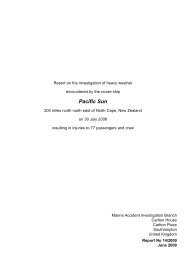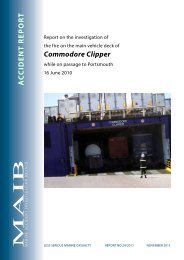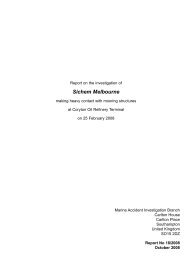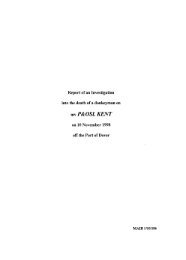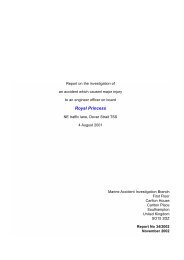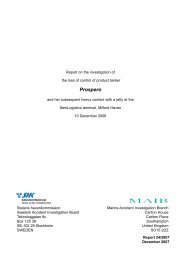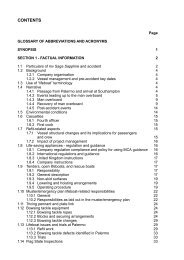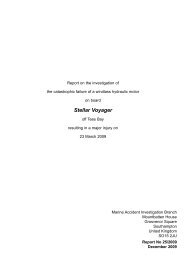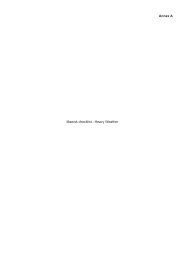Part 1 - Merchant Vessels - Marine Accident Investigation Branch
Part 1 - Merchant Vessels - Marine Accident Investigation Branch
Part 1 - Merchant Vessels - Marine Accident Investigation Branch
You also want an ePaper? Increase the reach of your titles
YUMPU automatically turns print PDFs into web optimized ePapers that Google loves.
It’s Such a Drag-ging Anchor<br />
Narrative<br />
While waiting to berth, a fully loaded oil<br />
product tanker was anchored about 1 mile<br />
from the nearest shoal patch. The wind was<br />
forecast to increase to Beaufort Force 9 that<br />
night. The master wrote his night orders,<br />
stating that he should be called if the anchor<br />
dragged or if required at any time. He then<br />
went to bed having given no instructions to<br />
be called if the weather deteriorated beyond a<br />
specified threshold. Later, a weather forecast<br />
was received stating ‘storm force winds soon’.<br />
The wind increased to Beaufort Force 10 and<br />
several other vessels nearby either dragged<br />
their anchors or sailed from the anchorage.<br />
The product tanker remained at anchor.<br />
In the early hours of the morning the ship<br />
started to drag her anchor towards the shoal<br />
patch. This had not been detected by the<br />
OOW, who was monitoring the ship’s position<br />
using only a single radar range and bearing line<br />
from a fixed beacon (Figure 1).<br />
The port’s duty Vessel Traffic Services Officer<br />
(VTSO), who was monitoring the anchorage,<br />
called the ship by VHF radio and asked the<br />
OOW to confirm if the ship was dragging<br />
anchor. Several minutes later the OOW alerted<br />
the duty engineer, who went to the engine<br />
MAIB Safety Digest 1/2012<br />
CASE 14<br />
room to start the main engine. The OOW then<br />
called the master. The master arrived on the<br />
bridge a few minutes later and sent the second<br />
officer and the duty seaman forward to recover<br />
the anchor. The master remained alone on<br />
the bridge hoping that, if all else failed, the<br />
ship would pass over the shoal patch even<br />
though the state of the tide was approaching<br />
low water. Once the main engine was started,<br />
the master, concerned that he could damage it,<br />
used only half ahead power to try to clear the<br />
shoal patch.<br />
The ship grounded stern-first onto the shoal<br />
around 30 minutes after starting to drag<br />
anchor, and pounded onto the rocky bottom<br />
several times as it pitched in the heavy seas.<br />
The rudder was put out of action and indicated<br />
on the bridge that it was hard-over. The port<br />
authority sent a tug to assist, however the ship<br />
continued to drag her anchor until the wind<br />
finally abated and the anchor held in deeper<br />
water on a rising tide.<br />
The ship sustained significant damage to the<br />
shell plating along her length; the hull was<br />
heavily indented, but it was not breeched and<br />
there was no pollution. The rudder and the<br />
steering compartment were badly damaged<br />
(Figure 2).<br />
39


